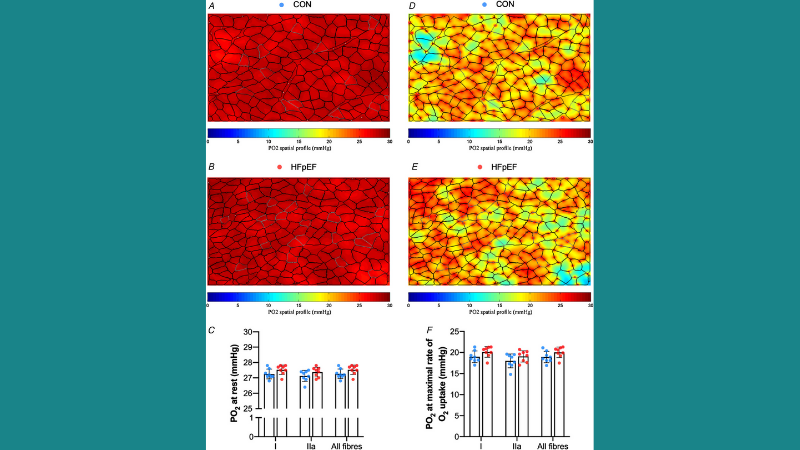Modelling of soleus muscle oxygen tension. Image courtesy of Espino-Gonzalez et al. (2021).
Best of 2021: Muscle Physiology
This publication review summarizes some of the best recent articles that fall under our Muscle Physiology category.
Abnormal Skeletal Muscle Blood Flow, Contractile Mechanics and Fibre Morphology in a Rat Model of Obese-HFpEF
In this article by Espino-Gonzalez et al. (2021), the authors used a rat model to determine the effects of heart failure on skeletal muscle mechanics and blood flow. The authors identified a knowledge gap in our understanding of skeletal muscle pathophysiology; their aim was to assess the skeletal muscle phenotype in vitro, in situ, and in silico. They compared lean rats with obese-heart failure with preserved ejection fraction (HFpEF). Aurora Scientific’s muscle physiology testing systems enabled the authors to assess performance. They used our 305B-LR force transducer to measure muscle function of the EDL in situ. For in vitro assessment, the authors attached soleus muscles to our 305C lever system and stimulated them using our 701C Electrical Stimulator. Diaphragm strips were mounted in a flow through bath and attached to our 300B-LR lever system for mechanics measurements. Finally, using our 605A Dynamic Muscle Data Acquisition and Analysis System, the authors were able to obtain and process their mechanics data. They concluded that obese-HFpEF induces skeletal muscle alterations that attenuates muscle function and impairs blood flow.
Loss of Dysferlin or Myoferlin Results in Differential Defects in Excitation-Contraction Coupling in Mouse Skeletal Muscle
In this article, Barefield et al. (2021) investigated the physiological role of the ferlin protein family that regulate tubule formation and whose loss results in severe muscle disease. Using our 701C Electrical Stimulator, the authors tested muscle pacing through stimulating isolated live myofibers taken from the flexor digitorum brevis (FDB) in wild type mice as well as those lacking dysferlin, myoferlin, or both dysferlin and myoferlin. Researchers also used our 900B sarcomere length system to visualize sarcomere shortening and 950A Calcium Fluorescence System to integrate Calcium Transient and SL measurements which provided analysis of pertinent transient parameters. The authors found that dysferlin and myoferlin have different roles despite their similarities when it comes to regulating tubular formation.
Targeted Genome Editing in vivo Corrects a Dmd Duplication Restoring Wild-Type Dystrophin Expression
Finally, in this article, Maino et al. (2021) explored tandem duplication mutations in the Dmd gene which is implicated in Duchenne muscular dystrophy (DMD). The authors created a novel tandem duplication mutation in a mouse model using CRISPR/Cas9. The duplication exhibited the DMD phenotype. They were then able to correct the duplication, again using a precise CRISPR/Cas9 strategy in vivo that restored dystrophin expression. They tested muscle contraction using our 1300A: 3-in-1 Whole Animal System. This novel approach opens new opportunities in correcting tandem duplication mutations and will lay the groundwork for future research and therapies for duplication mutation-related disorders.




